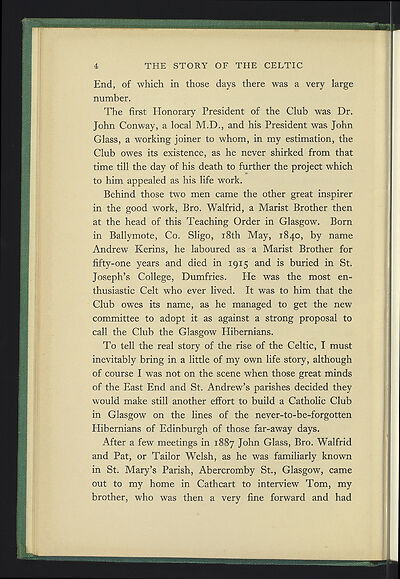Story of the Celtic
(18)
Download files
Complete book:
Individual page:
Thumbnail gallery: Grid view | List view

4 THE STORY OF THE CELTIC
End, of which in those days there was a very large
number.
The first Honorary President of the Club was Dr.
John Conway, a local M.D., and his President was John
Glass, a working joiner to whom, in my estimation, the
Club owes its existence, as he never shirked from that
time till the day of his death to further the project which
to him appealed as his life work.
Behind those two men came the other great inspirer
in the good work, Bro. Walfrid, a Marist Brother then
at the head of this Teaching Order in Glasgow. Born
in Ballymote, Co. Sligo, i8th May, 1840, by name
Andrew Kerins, he laboured as a Marist Brother for
fifty-one years and died in 1915 and is buried in St.
Joseph's College, Dumfries. He was the most en-
thusiastic Celt who ever lived. It was to him that the
Club owes its name, as he managed to get the new
committee to adopt it as against a strong proposal to
call the Club the Glasgow Hibernians.
To tell the real story of the rise of the Celtic, I must
inevitably bring in a little of my own life story, although
of course I was not on the scene when those great minds
of the East End and St. Andrew's parishes decided they
would make still another effort to build a Catholic Club
in Glasgow on the lines of the never-to-be-forgotten
Hibernians of Edinburgh of those far-away days.
After a few meetings in 1887 John Glass, Bro. Walfrid
and Pat, or Tailor Welsh, as he was familiarly known
in St. Mary's Parish, Abercromby St., Glasgow, came
out to my home in Cathcart to interview Tom, my
brother, who was then a very fine forward and had
End, of which in those days there was a very large
number.
The first Honorary President of the Club was Dr.
John Conway, a local M.D., and his President was John
Glass, a working joiner to whom, in my estimation, the
Club owes its existence, as he never shirked from that
time till the day of his death to further the project which
to him appealed as his life work.
Behind those two men came the other great inspirer
in the good work, Bro. Walfrid, a Marist Brother then
at the head of this Teaching Order in Glasgow. Born
in Ballymote, Co. Sligo, i8th May, 1840, by name
Andrew Kerins, he laboured as a Marist Brother for
fifty-one years and died in 1915 and is buried in St.
Joseph's College, Dumfries. He was the most en-
thusiastic Celt who ever lived. It was to him that the
Club owes its name, as he managed to get the new
committee to adopt it as against a strong proposal to
call the Club the Glasgow Hibernians.
To tell the real story of the rise of the Celtic, I must
inevitably bring in a little of my own life story, although
of course I was not on the scene when those great minds
of the East End and St. Andrew's parishes decided they
would make still another effort to build a Catholic Club
in Glasgow on the lines of the never-to-be-forgotten
Hibernians of Edinburgh of those far-away days.
After a few meetings in 1887 John Glass, Bro. Walfrid
and Pat, or Tailor Welsh, as he was familiarly known
in St. Mary's Parish, Abercromby St., Glasgow, came
out to my home in Cathcart to interview Tom, my
brother, who was then a very fine forward and had
Set display mode to:
![]() Universal Viewer |
Universal Viewer | ![]() Mirador |
Large image | Transcription
Mirador |
Large image | Transcription
Images and transcriptions on this page, including medium image downloads, may be used under the Creative Commons Attribution 4.0 International Licence unless otherwise stated. ![]()
| Sports publications > Story of the Celtic > (18) |
|---|
| Permanent URL | https://digital.nls.uk/231810184 |
|---|
| Description | More than 230 sports publications from the National Library of Scotland's collections. Featured sports include football, rugby, golf, shinty, athletics, bowls, cricket and hockey. Among the material from the late 19th and early 20th centuries are match programmes, club histories, and handbooks. From the late 20th century are promotional materials to encourage greater diversity in sport. Most items cover sports activities in Scotland. There are also publications relating to the Olympics and international matches. |
|---|---|
| Additional NLS resources: |
|

